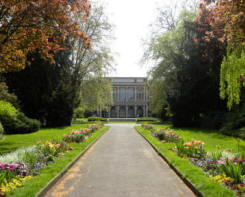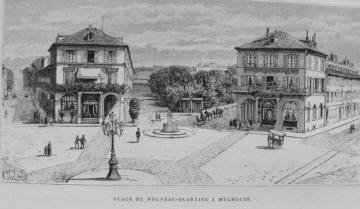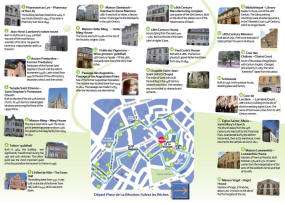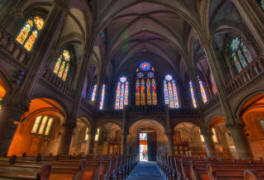|
FOLLOW THE
GUIDE!!!
The Place de la Réunion & the Historical Centre
The Place de la Réunion, at the heart of the old town,
formerly known as Place Saint-Etienne, was thus named
when Mulhouse became part of France in 1798.
In the Middle Ages, it was already the centre of political,
religious and economic life, as the site where fairs and markets
took place. Nowadays,
Place de la Réunion is still lined by a series of narrow,
colourful houses, which are among the oldest in the town, along
with the old Town Hall and Saint Etienne Protestant Church.

The former Town Hall
Built in 1552, this Renaissance gem symbolises the small
republic’s attachment to its liberties. The frescoes, repainted
in 1699 by the Mulhouse painter Jean Gabriel following
a fire, illustrate the virtues extolled by the reformed religion
as well as the coats-of-arms of the Swiss cantons to
which Mulhouse was allied.
During his trip to Mulhouse, Montaigne described this building
as a “magnificent, golden palace”. Upon the right-hand gable
hangs the Klapperstein, or “rattle stone”, which malicious
gossips were
forced to wear round their necks on market days as punishment.
The original is preserved at the History Museum.
The Nouveau Quartier
Symbol of
Mulhouse’s flourishing industry
 In the 1820s, the town was suffocating behind its medieval
ramparts, due to the growing number of factories and workers. In the 1820s, the town was suffocating behind its medieval
ramparts, due to the growing number of factories and workers.
Built from 1826 to 1841 near to the station, this business
district symbolises the success of Mulhouse’s industrialists.
It is also known as the Quartier de la Bourse (the
exchange district), as it contains the Industrial Society
building where the cotton exchange originally had its
headquarters. Built in the Empire style, it is also inspired by
Rue de Rivoli in Paris.
The square’s triangular shape is a sign of the industrialists’
links to Freemasonry. This urban heritage became a listed
historic monument in 1986.
 |

Map of
the "Sentier du Vieux Mulhouse"

Temple St Etienne
This neo-Gothic reformed
church, designed by the architect Jean-Baptise Schacre, is the
highest Protestant building in France.
Built on the site of an old Catholic parish church dating from
1305, it inherited the
magnificent stained-glass windows, produced between 1324 and
1351.
The scenes are taken from the Old and New Testaments. Unique in France,
Saint-Etienne Temple is the only place that has a gallery that
lets you get close to the stained glass windows in order to
admire their finesse and their beauty.


|